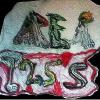As messy as all this information is, you guys are putting in a lot of effort here and I really appreciate it. But before I tackle your last posts, I want to address another confusing aspect of NAC and its relationship with Nitric Oxide.
Antioxidant N-acetylcysteine restores systemic nitric oxide availability and corrects depressions in arterial blood pressure and heart rate in diabetic rats.
http://www.ncbi.nlm....pubmed/16390827
"Systolic, diastolic and mean arterial blood pressures (SBP, DBP and MAP) and heart rate (HR) were reduced in diabetic rats (P<0.05 vs. C) and NAC normalised the changes that occurred in the diabetic rats. The protective effects may be attributable to restoration of NO bioavailability in the circulation."
The Effect of Different Antioxidants on Nitric Oxide Production in Hypertensive Rats
http://www.biomed.ca...ppl 1/55_S3.pdf
"Mechanisms responsible for blood pressure reduction appear to be related to both the decrease of reactive oxygen species level and the increase of NO production indicated by the elevation of NO synthase activity and eNOS protein expression. Recently, we have also demonstrated that chronic NAC treatment prevented the development of L-NAME-induced hypertension in adult WKY rats. This effect was associated with increased NOS activity and enhanced NO-dependent vasodilation (Rauchová et al.2005, Zicha et al.2006). NAC treatment also increased NO synthase activity in the developed form of L-NAME-induced hypertension, but without lowering blood pressure, i.e. similarly as in the developed form of spontaneous hypertension (Rauchová et al. 2005)."
"Finally, Ramasamy et al. (1999) demonstrated that N-acetylcysteine increased endothelial NOS (eNOS) expression in cultured bovine aortic endothelial cells on both mRNA and protein levels and increased NO synthase activity. Thus, the mechanisms of increased NO production by NAC treatment include increased expression of eNOS mRNA and protein which leads to increased NO synthase activity. It is evident that NAC may increase NO synthase activity by stabilization of its dimeric form due to decreased ROS level. NAC may also protect already synthetized NO from oxidation by scavenging oxygen-free radicals (Lahera et al. 1993), and by forming nitrosothiols (Myers et al. 1990). Both effects could prolong NO half-life and potentiate its effect. The increased production of nitric oxide in developed form of hypertension is, however, less functionally effective due to either inactivation of nitric oxide by ROS, simultaneous release of endothelium-dependent vasoconstrictors or due to anatomical changes such as the hypertension-induced intimal thickening, which attenuates NO action on vascular smooth muscle cells."
N-acetylcysteine improves nitric oxide and alpha-adrenergic pathways in mesenteric beds of spontaneously hypertensive rats.
http://www.ncbi.nlm....pubmed/12850392
"The increase in NO-mediated vasodilator tone and the possible decrease in adrenergic vasoconstriction induced by NAC treatment in SHR could explain the hypotensive effect of NAC in this model of hypertension."
The effect of N-acetylcysteine on renal function, nitric oxide, and oxidative stress after angiography
http://www.nature.co...s/4494143a.html
"NAC treatment prevented the reduction in urinary nitric oxide after angiography."
"NAC treatment has renoprotective effect in patients with mild chronic renal failure undergoing coronary angiography that may be mediated in part by an increase in nitric oxide production."
From these 4 studies, it is very clear that NAC improves/increases nitric oxide production. OR IS IT?!?!?!?
N-Acetylcysteine Inhibits in Vivo Nitric Oxide Production by Inducible Nitric Oxide Synthase
http://www.sciencedirect.com/science/article/pii/S1089860301903568
"These results demonstrate that NAC administration can modulate the massive NO production induced by LPS. This can be attributed mostly to the inhibitory effect of NAC on one of the events leading to iNOS protein expression. This hypothesis is also supported by the lack of effect of late NAC administration."
N-acetylcysteine prevents nitric oxide-induced chondrocyte apoptosis and cartilage degeneration in an experimental model of osteoarthritis.
http://www.ncbi.nlm....pubmed/19725096
"These results indicate that NAC inhibits NO-induced apoptosis of chondrocytes through glutathione in vitro, and inhibits chondrocyte apoptosis and articular cartilage degeneration in vivo."
N-Acetylcysteine Negatively Modulates Nitric Oxide Production in Endotoxin-Treated Rats Through Inhibition of NF-κB Activation
http://online.lieber...journalCode=ars
"Both inhibit NO production, although NAC lacks any effect if given when iNOS is already induced; this indicates that the decrease of NO generation is not due to an effect on iNOS activity."
WHAT THE FLYING F***!!!!!!!!!!!! How can these contradictory studies exist together? Where is the consensus in the science? I'm in my third year in University studying Biology, but I guess I need to hit the books more because I am feeling lost and frustrated with all this data. I would love some help interpretting these.
Edited by Furniture, 02 October 2015 - 08:40 AM.
















































